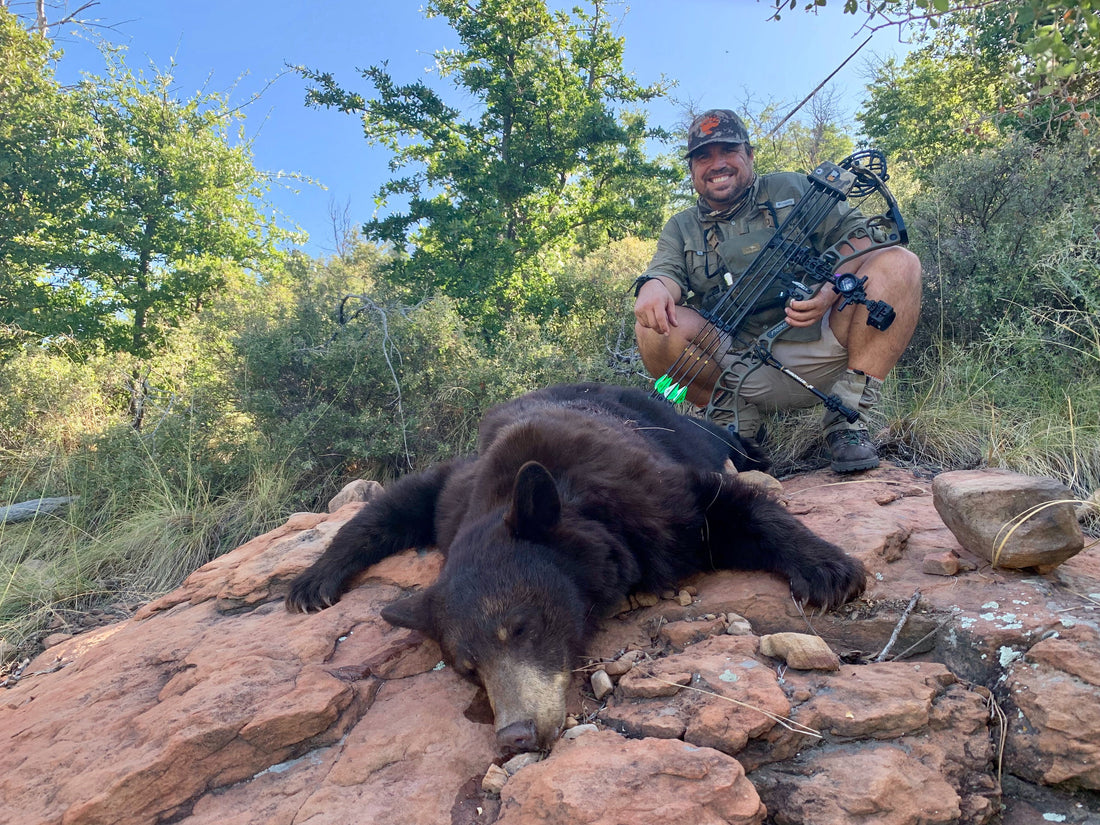When I think of black bears, I think of wilderness. That’s because bears are synonymous with wilderness. Bears are an indicator species, when we have a robust population of black bears, we also have healthy ecosystems. In North America, black bears are flourishing. Managed through hunting and the North American Model of Wildlife Conservation, we are able to enjoy this magnificent species on the landscape as a functioning component of intact ecosystems and also in our homes as a healthy source of protein. Bear meat is delicious and a family favorite in my home. Not only do they provide healthy meat, but they also provide oil for cooking and fine pelts.
There can sometimes be mixed emotional feelings surrounding bear hunting, so please allow me to start here: I am a naturalist first and a hunter second. Healthy habitat and healthy wildlife populations, both game and non-game species, are of the foremost importance to me.

Hunting, while a significant component of our evolution and an undeniable part of the human experience, is absolutely second. Whether it be bears, deer, or rabbits, hunting can only be justified when wildlife populations are at a level to allow take of the surplus population. There are more bears now, and reaching older age classes, than there have been in the past century.
This success is attributed to careful population management of which hunting plays the primary role. With careful management and habitat conservation, which is funded and executed primarily by those that have a tangible connection to the animals and the wild places they live, we can continue to have, and even increase bear, and other wildlife populations into perpetuity.
Like I mentioned above, bear is the favorite meat in my family. It lends itself to a variety of preparations and dishes. Let’s walk through the whole animal and I’ll describe what we like to do with the various parts in my household.
Starting with the non-edible parts, I always keep the skull. Adorning a bookshelf, it makes for a beautiful memento of the hunt and an interesting conversation piece. Same with the hide, but it can also be taken a step further and made into garments. A bear hide is a beautiful thing and should never be wasted.
Moving on, one of the most valuable components of the animal in days past was the fat. Indigenous peoples and early European settlers depended on bears as a valuable and necessary source of fat. Today, it is still valued by those that hunt them. It can be rendered down and used for everything from cooking oil to leather conditioner. Even those that don’t hunt bears have likely heard of legendary bear fat biscuits.
Now, working from the front to the back. The neck, this is likely my favorite cut. Full of tough muscle and tendons, this cut would be rendered almost inedible on a grill but braised low and slow all that cartilage melts away and all that tough meat becomes so tender it literally falls off the bone. At this point, it can be used for all sorts of dishes, but my favorite is to mix with chile verde and use as taco meat.
Moving back, we reach the shoulders. With characteristics similar to the neck, braising is again in order. Just one way I like to braise the shoulders is in apple cider. The cider matches well with the slight sweetness of bear meat and this makes for a wonderful roast served with roasted sweet potatoes.
Just below the shoulder, are the shanks. Bear shanks, otherwise known as big muscular forearms, cut into rounds, are the perfect cut for the elegant Italian dish, Ossobuco. Next are the ribs, bear ribs are very meaty and absolutely delicious! Done using the 1-2-3 smoker method, or simply cooked in a slow cooker with some BBQ sauce, you’ll be in for a real treat.
Now the backstraps and tenderloins. These are the undefeated most popular cuts in hooves animals for the fine steaks they make, but since bears are carriers of the parasite Trichnellosis, all meat must be cooked to a minimum of 160° F. Temperatures this high don’t make for very good steaks, so these cuts get ground for burgers, lasagna, chili, etc.
Finally, we’ve reached the rear quarters, or back hams. Hams are exactly what I do with these. Brined for about a week, then smoked to temperature, you can make a ham better than any you could ever buy from a store. This makes for an extra special dish at a family Easter or Christmas, or it serves up just as well for ham sandwiches the rest of the year. Don’t forget to save the bone for a pot of beans or potato soup.

Speaking of bones, I would be remised if I didn’t mention bone stock. Bear bones make an exceptional stock that can be used in applications ranging from soup, braising, to simply enjoying a hot cup on a cold night. If you’ve never considered hunting bears, I hope this encourages you to give it a try. Bears are an undeniably impressive animal and provide some of the best, and most versatile, table fair of
any game species. Furthermore, the more people taking to the woods to pursue these animals and developing a personal and tangible relationship with them, the more people there will be to look out for them and fight to keep the public lands and wilderness they call home intact and protected for generations to come.
In the words of Clay Newcomb, owner and editor of Bear Hunting Magazine,
“Keep the wild places wild, cause that’s where the bears live."


